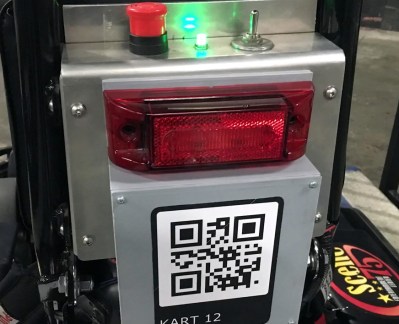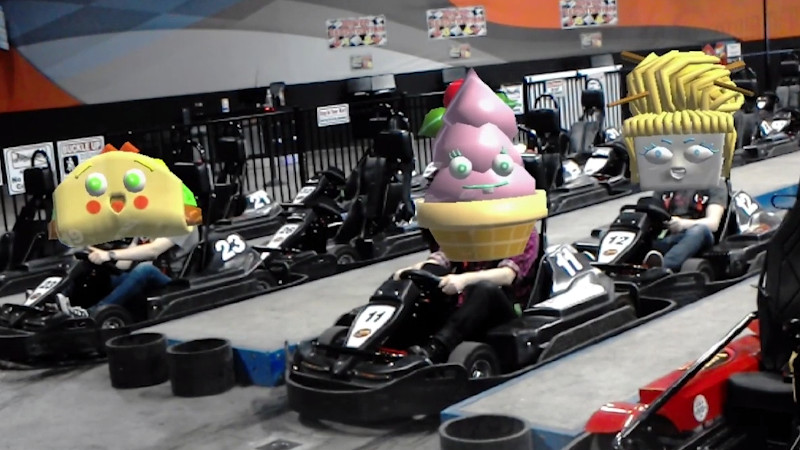There aren’t a lot of video game experiences we can easily recreate in the physical realm. You’ll quickly find that jumping on mushrooms in the real world doesn’t have nearly the same appeal as it does in Super Mario, and we won’t even get into the dangers of trying to recreate Frogger on your local multi-lane. But video game style go-kart racing? We have all the technology to pull that off, somebody just has to put all the pieces together.
Which is precisely what [Ian Charnas] is trying to do with his latest project. Using Microsoft’s HoloLens augmented reality headset, electric go-karts, 433 MHz wireless transceivers, and some Arduinos sprinkled in, he’s created the closest thing to Mario Kart that us flesh and blood mortals are likely to experience anytime soon.
 The HoloLens headset worn by each driver overlays the necessary graphical elements like pickups and weapon effects, as well as puts over-the-top cartoon heads on the other racers. But of course, that’s only half of the story. Seeing the pickups and gadgets doesn’t do you any good if they don’t have any effect on the actual race.
The HoloLens headset worn by each driver overlays the necessary graphical elements like pickups and weapon effects, as well as puts over-the-top cartoon heads on the other racers. But of course, that’s only half of the story. Seeing the pickups and gadgets doesn’t do you any good if they don’t have any effect on the actual race.
To that end, [Ian] has come up with a way to control the performance of the go-karts using an electronic “backpack” that mounts to each kart. So speed boosting pickups actually make the kart go faster, and if a driver gets hit with a weapon fired at them, they get slowed down.
That’s the high-level version, anyway. There’s obviously a lot going on behind the scenes, some of which are detailed on the Hackaday.io page. One of the interesting notes is that the HoloLens needs visual markers to orient itself, which in the video after the break can be seen as black and white posters dotting the walls alongside the track. As the project progresses, [Ian] is hoping that these can be camouflaged in creative ways (such as being made to look like audience members or checkered flags) to make the overall experience more immersive.
According to [Ian], the next step is to find partners who want to help elevate this from a one-off project to something that you might actually see at an amusement park. We wish him luck, if for no other reason than we really want to play the thing ourselves. In the meantime, we’ll have to settle for racing hacked Power Wheels.
















That’s pretty cool
Top Golf anyone? This could easily be developed into a working experience… it isnt too far removed from the models for top golf or laser tag. There is very little demand for a nascar or formula 1 experience but I would venture to guess there is a pretty decent market for a live action, interactive Mario Kart experience.
Thanks for the commend Robert and great point about Top Golf and Laser Tag. Actually… AR could take Laser Tag to the next level. Hmm…
https://www.battlekart.eu/en/home
Up to 12 people =)
Thanks Valentin! I noticed Battlekart as I was developing this. Battlekart has a great solution and I like the gameplay concepts they developed. The big upside to what they’re doing is that no visors or goggles are required, so it’s faster for the venue and more comfortable for the user. The downside is that the images are not 3D holograms, and the super low-latency IR beacon system that locates each kart is a 6-figure budget item (at least, according to the quote I got) because of all the DSLR cameras and computational power required to do real-time outside-in tracking on 12 targets. That having been said, I would love to get to play Battlekart in person, it looks totally fun and the creators are clearly very talented, smart, and creative people.
This is an awesome fun hack, but something that is utterly impractical and a safety nightmare waiting to happen.
– Impractical – Hololens and similar grade hw is $2000-3000 a piece. A *very fragile* piece. With literally no warranty by Microsoft (do read that EULA!). The idea of using this (or similar HW) in a public amusement park attraction is nuts, IMO. I am sure there will be something more robust on the market later on but it will be still very expensive (the optical waveguides used in the Hololens displays cost about $600 alone).
– Safety nightmare – cart racing with no helmets? Who the heck would insure a park attraction like that? Maybe bumper cars.
OK, helmets aside, the last thing anyone would want to wear while driving anything where *crashing into things is the objective* is a piece of fragile glass an inch from your eye. Sooner or later someone will get really badly hurt because of this.
The only way this could be done safely would be a helmet with an integrated HUD display – there are some motorcycle helmets attempting to do this (HUD), maybe something could be done for feeding the AR image overlay feed into this. The tracking doesn’t really need to be built-in – the racing is on an closed track, there is no problem to rig the setup with outside-in tracking (e.g. something like cameras, Valve’s Lighthouse, etc.) – that would make the helmets much simpler and lighter (important, the more mass you have on your neck the higher the g-force effects while cornering, braking, accelerating, etc. – you do want to keep this as lightweight as possible). However, no matter what, that’s going to be custom hw => expensive as heck.
The helmet idea is basically describing what you find in military Jets and more recent helicopters. Definitely not something that comes cheap but yeah I would say you are spot on that the safety risks on this thing simply cripple the idea from the perspective of a business. I can’t imagine a single insurance company being willing to insure this no matter how much money you gave them.
Jan, thanks for your insightful comments.
Great question about the helmets. This system is designed to operate at 10-15 miles per hour
(16-24 km/h), because that’s as fast as the HoloLens 1 will track its surroundings. At that speed, you don’t need a helmet, and I haven’t personally seen a venue that provides helmets at that speed. The karts have a double bumper system (two concentric rings of 1″ HDPE separated from each other and the kart by hollow rubber triangular springs) so that even if you slam into a wall (or another driver) at full speed, the deceleration is surprisingly soft. That system, combined with the racing harnesses and low speeds, makes this the safest kind of go-karting out there. Although the digital content does distract drivers, the karts are designed for bumping and collisions and will keep players safe. I can share with you that in practice we’ve seen more bumping and wall slamming due to bad driving habits than anything caused by the game. To be clear, the game does not involve “crashing into things as [an] objective” as I agree with you that would not be wise, even with all the safety features.
The HoloLens is an expensive piece of hardware, as you rightly pointed out. Family entertainment centers are used to dealing with maintaining expensive equipment though. Many of their amusements are expensive and break regularly due to rough use and they need maintenance often. In all of our testing we had no issues with the HoloLens breaking, but in the production version we’ll have the system tethered to the cart’s roll cage bar so it can’t fly too far if it gets loose from someone’s head. Amusement parks frequently already have VR and AR systems in place on other amusements, so in my discussions with them the maintenance issues were ones they are already used to dealing with.
You mentioned having a piece of “glass” close to your eye, but it turns out the HoloLens is made of non-splintering plastic, and the front piece is made out of the same sort of impact resistant plastic that helmet windows are made out of. I don’t see a safety concern there, but it was definitely something I looked into when I first started developing this, so I completely understand your curiosity and desire to be safe.
I hope this relieves some of your concerns… but if this is not your cup of tea, no worries at all.
In any case happy new year to you and your family,
Ian
Hololens may be made out of non-splintering plastic but that flat display area in front of your eye is definitely optic grade (i.e. not safety) glass. There is that plastic shield in front of it but that won’t stop any serious impact.
The “crashing into things being the objective” was not meant that the software incentivizes this but that people will inevitably do it – trying to block opponents, the poor driving you have mentioned, etc.
Whether or not this is my cup of tea is really irrelevant, but as someone who’s day job for the last 20 years is dealing with this type of hw (including the Hololens), I find the lack of attention to safety disturbing. The last thing the industry needs is a heavy handed government regulation because someone got injured on a poorly thought out amusement park attraction.
And re fragility of Hololens – there is a big difference between doing your in-house testing and letting e.g. a group of teenagers loose on the gear, many times a day. Given the costs and zero availability of spare parts from Microsoft (they literally don’t sell any – we broke the head strap on ours and it took quite a bit of negotiation before we convinced them to sell us a replacement one), I really do wonder how you imagine maintaining this equipment when the thing will inevitably wear out and break. Most park attractions that use VR either use cheap consumer gear (so when things break it is easy and cheap to replace) or have custom designed, ruggedized solutions. Not a $3000 piece of fragile lab gear with no replacement parts available. And they don’t have people driving around at 15mph in it neither.
Happy new year to you as well.
>There is that plastic shield in front of it but that won’t stop any serious impact.
I imagine that an impact hard enough to put an eyeball through the shield would be so violent that whatever is behind that shield is of little consequence.
Hi DH, and thanks for that comment.
I agree with you on this. The hololens visor is polycarbonate, just like the impact resistant face shields we use in laboratory testing environments, or ones in racing helmets. Jan is correct that it’s thin and won’t stop all forms of projectiles, but if something hits you with enough force to break a polycarbonate visor, it really doesn’t matter whether that visor is inside of a helmet or a hololens, the person inside would get hurt. Since nothing in the go-kart track is capable of causing that much damage, I’m not able to see how the game could be the cause of such an incident.
Great response to the negative vibes that happen on HaD sometimes and a good reminder to people that, just because something isn’t mentioned in the article, the shouldn’t assume after 2mins reading that people are fools and haven’t thought about the basics of the project that they’ve been spending loads of time on.
Good luck with your project Ian!